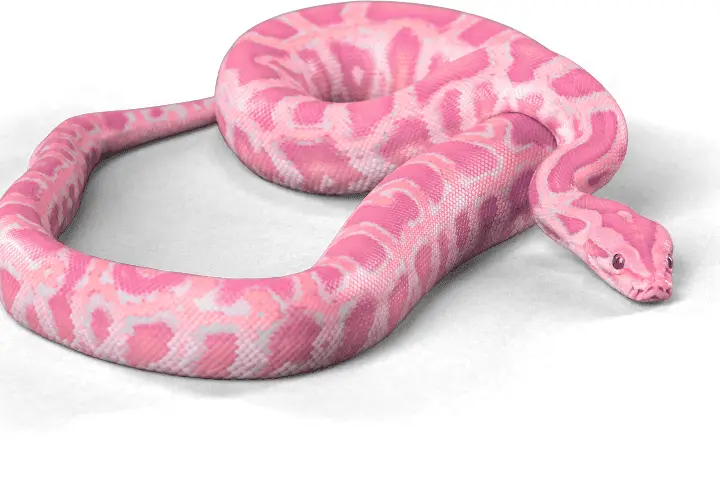Are Pink Snakes Real
Do pink snakes really exist? This question has captured many imaginations.
Most snakes are green, brown, or black. However, some species have a pink color!
Not just creative tricks or Photoshop; they are real!
This rare phenomenon is mysterious and puzzling. The colour is due to a genetic mutation called erythrism.
This is an overproduction of red pigments, giving the snake a vibrant pink hue. It is caused by variations in genes responsible for pigmentation.
One example is the albino Burmese python. They lack melanin pigment, resulting in a pale, pinkish look.
They are popular exotic pets because of their striking colour and large size.
Explaining the concept of pink snakes
Are pink snakes real? Yes! These captivating creatures have an extra-special hue that sets them apart.
It’s called erythrism, and it’s a genetic mutation that causes an excess of red pigmentation. So instead of relying on camouflage for protection, these serpents use their eye-catching color to ward off predators.
The rose-colored boa constrictor is a popular pink snake species found in Central and South America. They blend right into the rainforest foliage, and look even more beautiful when the sun hits them.
India also has its own unique pink snake – the Pink Panther. Its vivid pink scales give it a touch of exotic charm.
Though they appear delicate, pink snakes are no joke. They have venomous fangs and can strike with deadly precision when threatened.
But generally, they prefer to avoid conflict and are known to be quite docile when left alone.
Pink snakes have long been admired by humans.
Ancient civilizations like the Egyptians saw them as sacred beings, and researchers today are still trying to unlock the secrets behind their unique coloration.
Research and scientific studies on pink snakes
Studies have revealed that pink snakes have a unique genetic makeup. This rare mutation causes their distinctive coloration.
Plus, scientists have noticed special behaviors in these serpents, such as nocturnal activity and camouflage.
Research also looks at pink snakes’ habitat choices. Studies show they live in tropical rainforests and semi-arid regions.
This helps us understand how environment affects their survival.
Myths and misconceptions about pink snakes
People have always been fascinated by pink snakes, leading to myths and misconceptions.
- Some think pink snakes are venomous. This is not true. The colour of a snake does not tell if it is venomous.
- Others believe pink snakes are rare and exotic. While certain species are uncommon, they can be found all over the world.
- People think all pink snakes are small. That is false. Pink snakes come in different sizes.
- Many assume pink snakes have no natural predators. Wrong! They still face threats from hawks, eagles, and larger snakes.
Plus, they may have special adaptations like camouflage and unique hunting strategies.
It’s important to know the facts about pink snakes. Species, size, behaviour, and predators all vary.
Understanding this helps us better understand these captivating reptiles.
Real-life examples of pink snakes
Snake Species, Native Region and Distinctive Features – these are the elements that make up the incredible groups of pink creatures.
Take the Rosy Boa, for example, found in the Southwestern United States and Mexico. It’s pale pink or salmon-colored with dark markings.
Or, the Pink-bellied Sideneck Turtle found in Australia, New Guinea and Indonesia. It has a bright pink plastron (underside of shell) with black mottling.
Lastly, the Jungle Carpet Python, found in Australia and New Guinea rainforests. It has a vibrant pink or peach-colored body with distinctive black patterns.
Did you know that the Pink Panther snake is fictional? It’s not based on a real snake species but is inspired by the allure and mystique of these amazing creatures.
On one herpetologist’s expedition in Costa Rica, they encountered an unexpected pink snake. It was hidden amidst the foliage and left them in awe! This sparked further interest in exploring the different hues of nature.
These instances remind us that there are real pink snakes out there. Whether pale or vibrant, they represent the endless wonders of wildlife.
Possible explanations for the pink coloration in snakes
Enigmatic pink coloration in snakes has left scientists and nature buffs perplexed! One hypothesis suggests a genetic mutation that alters pigment production in their skin.
This mutation may offer them camouflage or attract mates.
Another explanation proposes that the hue is from their diet. Consuming pink-hued insects or crustaceans may accumulate these pigments in their skin.
It’s also possible that environmental factors are at play, like specific minerals or compounds in the soil or water.
We need further research to uncover the mysteries of pink snake coloration. It could provide insights into genetics, ecology, and evolution.
Conclusion
The notion of pink snakes has captivated people for years.
Some think they’re only imaginary, but others say they’ve seen them in the wild.
If real, these snakes would be an amazing part of biodiversity.
Questions arise about their color and how it fits in with evolution and ecology.
Concealment or attracting mates could be the reason behind it.
We have no proof that pink snakes exist, yet stories exist.
People who claim to have seen them usually state they were in unfamiliar areas, making it hard to prove.

